Space
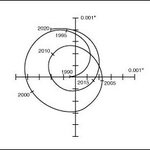
The discovery of Gliese 581g was cause for rampant hype almost everywhere but here, along with some rather ridiculous claims that there was a 100% chance of life there.
The actual paper authors were more reserved, though astronomy is far bolder than biology in terms of its participants hyping findings and generally physics is pretty reserved (exception: LHC claims when it was being funded and built - now that the marketing is over, the call for perspective has set in) outside dark matter and dark energy, where anything goes.
So some understanding of what 'finding' a planet means is needed…

New research is challenging the belief that the planet Neptune knocked a collection of planetoids known as the Cold Classical Kuiper Belt to its current location at the edge of the solar system.
The Kuiper Belt is of special interest to astrophysicists because it is a fossil remnant of the primordial debris that formed the planets. University of Victoria Ph.D. student Alex Parker presented his results at today's meeting of the Division of Planetary Sciences in Pasadena, California.Parker and his thesis supervisor Dr. J.J. Kavelaars (Herzberg Institute of Astrophysics) studied binaries;…
The Chinese Chang'e series is taking over the moon. For lunch, NASA people in Florida are heading to bread lines, while meanwhile the Chinese are microwaving the entire moon for their own consumption. Okay, I'll ditch the mixed jingoistic metaphors now and get to what really makes me hungry-- space exploration successes.
With 1 down, 1 flying, and several more coming, the Chang'e program is starting off with strong successes. The Chang'E-1 mission mapped the entire moon in microwaves, with data presented at the European Planetary Sciences Congress conference last month (…

Despite vast great differences between the atmospheres of Venus and Earth, it turns out very similar mechanisms produce lightning on the two planets. The rates of discharge, the intensity and the spatial distribution of lightning are comparable - which may help us understand the evolution of the atmospheres of the two planets. Early missions, such as the Venera orbiters and probes, followed later by the Pioneer Venus Orbiter and more recently by the Galileo spacecraft, have reported evidence for optical and electromagnetic waves from Venus that could be produced by lightning. This was…

Scientists have discovered a new type of solar wind interaction with airless bodies in our solar system. Magnetized regions called magnetic anomalies, mostly on the far side of the Moon, were found to strongly deflect the solar wind, shielding the Moon’s surface, a discovery which will help us to understand solar wind behavior near the lunar surface and how water may be generated in its upper layer.
Atmosphere-less bodies interact with the solar wind quite differently than the Earth. Their surfaces are exposed without any shielding by a dense atmosphere or magnetosphere, which causes…
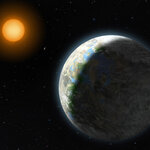
A team of planet hunters has announced the discovery of an Earth-sized planet (three times our mass) orbiting nearby star Gliese 581 at a distance that places it squarely in the middle of the star's 'habitable zone', where liquid water could exist on the planet's surface.
If confirmed, this would be the most Earth-like exoplanet yet discovered among the nearly 500 known extrasolar planets - and the first strong case for a potentially habitable one. To astronomers, a 'potentially habitable' planet is one that could sustain life, not necessarily one that humans would consider a nice place…
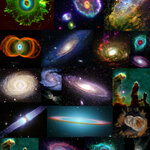
Cosmology has been crossing my transom. I've been getting press releases from the new online Journal of Cosmology. Below is a sample. They have a respectible team and, frankly, a kick-ass background image for their website (shown below).
And, they have a novel economic model-- a $35 submission fees, plus a $150 fee if published. Given most academic journals are free to submit but have fees upwards of $1000 to publish, it could be seen as a breakthrough in open journals. However, much as any writing gig that charges a submission fee, I am worried they are more…
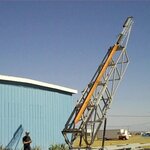
Ever want to build your own launch rail? Interorbital Systems did, and sent me pictures.
I know, I know, you're thinking "aren't all the cool kids building their own rockets instead?" Yeah-- and what are they gonna launch them off, huh? Didn't think that far, huh? So you're going to show up in a desert or tropical island somewhere with a rocket and be all "where shall I stick this?" And the locals will be happy to tell you where to stick it. Trust me, you need a launch rail for your rocket. It's like the pod for the pea.
CPM TV…
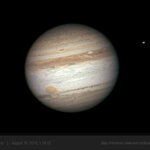
A number of important things have happened since 1963. In September, 1965, for example, Bob Dylan heralded in the modern rock album with "Highway 61 Revisited"(1) and my mother was so excited about a Sandy Koufax no-hitter for the Dodgers she went into labor(2) and gave birth to me.
One thing that has not happened since 1963 is Jupiter being this close to Earth - but the gap won't be so long until the next - 12 years, according to NASA. It's a mathematical circumstance because Jupiter's orbit is 12 times as long as Earth's. Earth laps its giant neighbor in just…

My last post about hydrogen bonding included a video about dogs as an analogy to the chemistry. This got me thinking about visual analogies, and how video or images can be used to convey something that perhaps print can't quite accomplish.
This video by Brad Plummer and Julie Karceski of SLAC (disclaimer -- they are both colleagues and friends) explains the concept of gravitational lensing -- in which a particularly large galaxy bends light in such a way that an observer can see objects behind the galaxy -- with a simple household item: the wine glass. Watch:
Phil's wine-glass-as-a-…